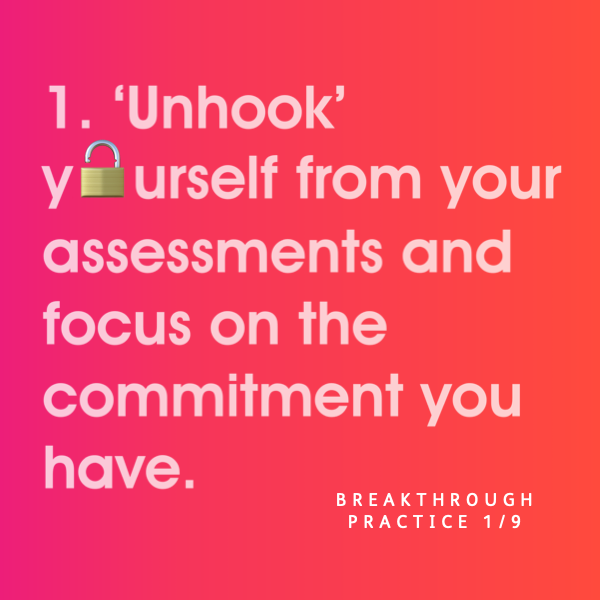Breakthrough Thinking Practice 1: Unhooking yourself from your assessments
Leadership Blog

Written by Achieve Breakthrough

Much in the same way a labourer cannot construct a building using only a hammer, leaders need a range of different practices in their toolkit in order to achieve breakthrough results.
This can sometimes mean shattering the shackles that tie us to our own human nature and shedding the behaviours that are hindering our journey towards breakthroughs. In this blog series we will unpack 9 mindset and behaviour practices for you to consider adopting if you want to set yourself on hyper-speed course to achieving extraordinary, breakthrough, results.
One such behaviour is our own assessments: our unconscious ideas about ourselves and others, ideas that often wreak havoc without us noticing.
Putting background assessments on the backburner
The first step in unhooking ourselves from our assessments is realising that we have them in the first place.
Assessments are not purely reactive and don’t occur as a result of a specific event, they are already ingrained within us. Our culture, upbringing, and our life events all shape the assessments that we have.
If someone arrives five minutes late for a meeting, they trigger your assessment about lateness - and you add an interpretation to their behaviour. Then if you see the same individual on their phone during the meeting, another assessment might be triggered. All of these assessments are lying in wait in the background, and we often don’t even realise they’re being triggered at the time.
Now say the same individual makes a large error at work, the conclusion you jump to about it will be determined by the filter of the background assessments you’ve already made. The facts surrounding the error will barely get to testify. Your own assessments have swung the gavel.
We need to realise: Our assessments are already running in the background and they’re often running the show. It’s the same story for everyone. And the only way out is to become radically aware of what’s going on behind the curtain.
Getting off the hook
A fantastic US-based coach we collaborate with here at Achieve Breakthrough says: “We cannot intervene in a world we cannot see.” And they’re so right! Only once we realise we have assessments, can we unhook ourselves from them.
They may be assessments about ourselves, for example: “I am not good enough at this task” or “People are checking their watches, they must be bored of what I’m saying.” Or they may be assessments about others.
There is nothing innately wrong about these assessments and everybody has them. Some of them might even be positive, such as: “I’m the right person for this role” or “I’ve got what it takes to do this.”
But when you’re going for a breakthrough, you need to be led by your commitment, not your assessments. Even positive assessments can lead you down the wrong track. There are moments when “I’m the right person for this role” might hold you back from delegating, setting your eyes on a larger target, or asking for help.
Ultimately assessments, whether positive or negative, are not the tools you need to achieve a breakthrough. Assessments are based on our past experiences. If we rely on them for guidance, we’ll end up recreating the past instead of moving into a future state.
Conversely, a commitment is based on a future state. “In the next two years, we will double in size.” Once we act on our commitments, regardless of our assessments, we’ll generate a new future and deliver a breakthrough.
Commitments vs assessments
An assessment is essentially an assumption, and we must be aware to challenge our assumptions when it comes to our decision making.
Let’s say you’ve worked with someone for five years and don’t dislike them, but don’t have a great chemistry with them either. Perhaps you exchange a casual “hello” at the coffee machine but they aren't at the top of your Christmas card list.
If one day they get promoted to a more senior position than you, your assessments will likely be running at double speed. If you enter your first meeting with that person armed only with these assessments, you’re likely to take a “wait and see” approach. If they get in gear on their end, you’ll commit to making it work on your end.
But if you are led by your commitment to a collective goal, (for example, “we will improve employee retention by 15% by November” or “we will break into a new sector by the end of the next fiscal year”), your approach to that first meeting with that senior leader will be different.
You won’t wait to see how you get on, because in order to achieve a breakthrough, you’ll know that you need to get on. To be in the driving seat of both the relationship and the strategy; you need to be acting from breakthrough commitments. And by acting from your commitments alone, you get the freedom to change and reinvent your assumptions. Which means nothing is impossible.
Looking to achieve the impossible? Get in touch to explore how we can help you ignite your ambitions.
Published 24/06/2024
Subscribe by Email
Achieve more breakthroughs. Get expert leadership ideas, insights and advice straight to your inbox every Saturday, as well as the occasional bit of news on us, such as offers and invitations to participate in things like events, webinars and surveys. Read. Lead. Breakthrough.
Tags
- Attracting talent
- Behaviour change
- Blended Learning
- Breakthrough Thinking
- Business partnering
- Career planning
- Change management
- Collaboration
- Communication
- Competitive strategy
- Creativity
- Decision making
- Developing middle management
- Developing millennials
- Developing talent
- Employee engagement
- Entrepreneurship
- High performing teams
- Hiring
- Human Resource Management
- Innovation
- Leadership development
- Learning technology
- Managing people
- Managing uncertainty
- Managing yourself
- Mergers & Acquisitions
- Mindset
- Motivating people
- Negotiation
- Organisational culture
- Organisational development
- Organisational values & purpose
- Performance management
- Productivity
- Programme Management
- Retaining talent
- Strategic thinking
- Strategy
- Strategy execution
- Succession planning
- Team development
- Work-life balance
Related posts
Leadership Blog
Leadership burnout: Expanding bandwidth to thrive through complexity
Achieve Breakthrough | 16/12/2025
Leadership Blog
What triggers you as a leader, and how to work with it?
Achieve Breakthrough | 09/12/2025
Leadership Blog
Why it’s impossible to lead with one foot still in your old role
Achieve Breakthrough | 03/12/2025
Leadership Blog
Why a leader’s true value lies in what they enable, not just what they know
Achieve Breakthrough | 25/11/2025
